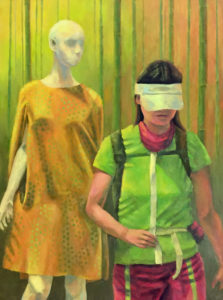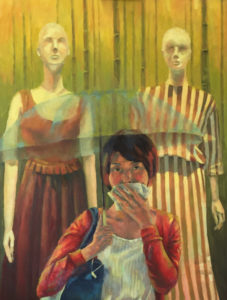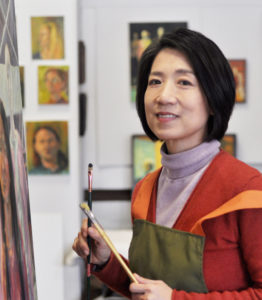Youngsheen A. Jhe
 In Between, Oil on canvas
In Between, Oil on canvas
What are your earliest memories of being artistic? As a young child, I was very sickly and frail. I often was not allowed to play outside and had to stay inside at home. I used books of paintings to escape my world and enter a more exciting and colorful one.
From the time I was in pre-school, it was clear I had a true talent in painting and drawing. Teachers throughout my elementary and middle school years recommended me to study art. But my parents refused to entertain this idea because they thought a degree in an academic field would be more beneficial. I was very shy, quiet, introspective and conservative. My nature led me to give up what I wanted to study.
When did art become a pursuit? I obtained a Masters Degree of Science in Korea and moved to the United States with my husband after marriage. As I became a mother of two and a supportive wife, I pushed my other dreams aside, lost in everyday life. I spent two years as a soap opera writer and then six years as a documentary translator and novelist back in Korea before my family moved to the States for a second time.
After obtaining my Green Card working for a Korean newspaper out of Boston, my forgotten dreams came back to me. Although my desire to paint was still there, I doubted that at my age, I could succeed as an artist. Modifying my dream, I was enrolled in the Museum Studies Masters Program at the Harvard Extension School. My goal was to study collection and to learn to become a curator. While I was at the Extension School, I took a painting class, just for the experience. The professor immediately saw the talent that so many of my other teachers had seen back in Korea. This professor took charge, put together a portfolio and did everything except fill out the online application for the post-baccalaureate studio art program at Brandeis University. And finally I came to the art world.
Are you self-taught or formally educated in visual art? I studied at Brandeis University for two years before obtaining my certificate of the post-baccalaureate studio art program. And then I obtained MFA from the University of New Hampshire.
How did you first become involved with CAA? I submitted my work to the National Prize Show in 2011 and my painting was accepted
In what other ways are you involved in the local art community? There are many ways to be involved in the local art communities, my particular interest is the “healing with arts” program. I was very surprised with patients’ response to my work when I showed my artworks at the Norris Cotton Cancer Center in Nashua, NH in 2016. Richard, the curator emailed me, “we hung the show in Nashua last week, and your work looks terrific. It was the first work we hung and it is in a spot where all the patients and staff see it. We had no sooner hung it than people sought us out to comment on how exceptional your work is! In the 33 shows we have hung, response to your work was the quickest to be expressed to us and everyone was quite taken by it for all the right reasons. You truly made an immediate impact.” After that, showing my works for patients and medical staff became my main precious mission as an artist. I also showed my artwork at the Cancer Center of the Dartmouth-Hitchcock in Lebanon NH and I will have solo show at the New London Hospital from September to December, 2019.
 Your Delight, Oil on canvas
Your Delight, Oil on canvas
What role do you think the artist plays in society? cleaning or refreshing people’s spirit and giving good feelings and emotion to them… Artworks inspire and remind the people of something they forgot, something they missed in their life
How do you choose your subject matter? Is there a reoccurring theme that carries throughout your work? My starting desire was to imagine a communication between a human being and a mannequin through a series of paintings that began eight years ago during staying in Italy for five weeks. I did not know any Italian, and they did not know any Korean or English. My inability to communicate made me feel as if I were a mannequin to them: I was alive, I was seeing them as they walked past me. With zero interactions, I merely observed them like mannequins do from their shop windows. Then I thought the contrary; that they were mannequins, and that I was the person. As a person, I began to wonder how I could communicate with them, mannequin-like people? Although it will never happen in a real world, I wanted to delineate the sadness and misery of disconnection of people’s soul in the modern life.
My work is a culmination of my past experiences as a foreigner in the United States, Europe and even Asia. I depict daily human life , juxtaposed with shop window mannequins. Through this juxtaposition, I describe the similarity between the lives of human beings and inanimate mannequins. We have a tendency to be aloof with one another. We have become either too indifferent or superficial to see beyond appearances of others. All of us are seemingly stuck in our own worlds.
But this similarity sometimes twists and turns into an irony; the intrinsic difference between the breathing humans and the lifeless mannequins begin to seem interchangeable. This irony is manifested in the world that we live in. Only things that seemingly await humans in dark streets are these mannequins displayed in show windows. They welcome and shine on people walking alone in dark streets. Even if these people walk in their own confinements, these mannequins greet them. Mannequins seem to become like the human beings or even the presence a Designer and His cherished designs.
I further seek to provide a commentary on this apparent interchangeability with a hint of satirical humor. I emphasize the interconnection between the world of humans and a world of mannequins; within this interconnection, I leave my annotation: there exists companionship and warmth within the mannequins for the people of this modern society.
As if to hold on to a fleeting wind, my objective is to capture the mundane and ordinary scene that passes by without a second thought: a morning jogger running next to a river, a pedestrian redoing his undone shoelaces, a moment of drinking and socializing in a party, or even a nun and police officer walking on the same sidewalk, each going to his and her separate destination. Each and every scene, whether ordinary or special, are the messages of the designed, which the Designer receives and views. If the Designer holds each message significant, then each and every scene must be significant. If all and every scene is significant, then perhaps everything about a person’s life is comprised of millions of “significants?”
The ultimate archetype that I I want to express the illumination of the Designer to the reality of the designed. To convey these archetypes, I employ fictitious lives of mannequins. These artificial mannequins that appear in my paintings, come bundled with light of the shop window. They juxtapose the implicit everyday reality of the pedestrians and visible lights emanating from the shop window, which eventually reach the pedestrians. Sometimes these mannequins represent the reflection of the reality of the pedestrians that walk adjacent to shop windows: isolated, alone and technically alive but seemingly lifeless and mechanic. Other times, the light from the shop windows that shine on pedestrians is reminiscent of the unseen presence of the Designer: perhaps, these mannequins, though lifeless, simply console the tired commuters, and provide tacit companionship to those that wander the night streets.
I travelled throughout three different continents to find mannequins that I can incorporate into the story. Armed with a camera, I walked through countless streets crowded with people, snapping events to find scenes that my eyes failed to register. Returning to my studio, I reviewed each photo over and over, each time finding different stories within each photo. Then the story is created by mixing different permutations of mannequins, persons, buildings and other ordinary objects found throughout the photos. The resulting story, though synthesized, is always completely unexpected.
I transcribe this story onto a canvas. My painting routine does not involve creation of smaller-scale models prior to painting on a full-sized canvas. Instead, as soon as I determine a composition in my head, I instinctively begin to transcribe my story onto a full-sized canvas. That said, the canvas does eventually end up including many iterations of the sketches and edits of the original composition prior to completion of the painting. My preferred method of painting is to create the full image in a large scale format, before removing unnecessary points in the painting. I prefer to simplify the full image into a smaller sized painting where only the most important aspects of the painting remain. While this method may be unorthodox, a deconstructive method grants me the clarity with which to view the translation of my story on the canvas.
My stories typically depict a cold and austere solitude, contrasted with the vibrant light emanating from shop windows: the bleakness of the night and brilliance of the light shining on the mannequins,, hollowness of the empty sidewalk and liveliness of the light and the mannequins. All of these juxtapositions and contrasts place emphasis on the existence of two contrasting worlds that every pedestrian faces. The conveyance of these two worlds, the light and the dark, is an echo of the world as seen by the designer, and expressed solely by colors. Unavoidably color gives life to my works.
 Enough I, Oil on canvas
Enough I, Oil on canvas
In your opinion, what’s your best/favorite piece you’ve made? I have a lot of favorite works … but I like the Kyoto series showed at Galatea Fine Art in Boston in 2017. I pulled the mannequins out of the show window to the bamboo forest and tried to depict intimacy between the human beings and mannequins. (Image of “Your Delight”, “In Between”)
I also like the “You Dancing” series, showed at the Pleiades Gallery in New York in 2018. (Image “Enough I”) Especially with Dancing Series, I tried to portray the invisible internal world of human beings, beyond visible external world. I wanted to convey to the viewer that they can find their soul dancing with God as they pass over each obstacles, even passing over obstacles appear as if they live and struggle on their own. I tried to depict this relationship as a dance by describing on the visible human body with the presence of light.
What is one of your artistic goals? Now I am trying to get away from the way I have been drawing so far. Instead of describing the mannequins in a realism way, I try to give them a sense of silhouette. I would like to express more freely in the works and not to be constrained by the rules. Maybe add abstraction elements in my realism style..? But it is not easy due to my character that is orderly, regular and good in organizing
What living artists are you inspired by? Linda Christensen, Susan Lichtman
Do you own any art by other artists? I own several Korean traditional ink paintings and also have small work of 19th century French painter. I recently purchased small work of Linda Christensen who I really admire.

See more Youngsheen!
Website: youngsheen.com
Instagram: youngsheen_a_jhe
